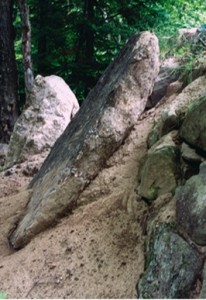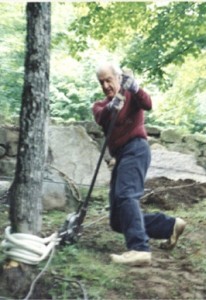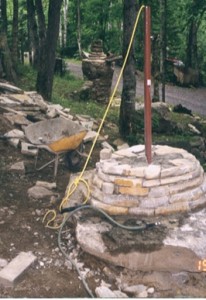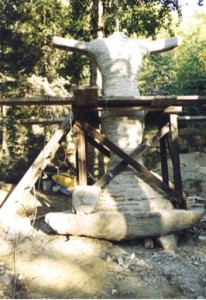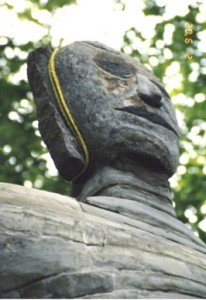2000 – 2003
Inukshuks are, by definition, constructed in the “image of man”. This sculpture, Universal Woman on a Half-Shell, is an attempt to pay homage to “woman”.Universal Woman on a Half-Shell was inspired in part by the iconic Botticelli “Birth of Venus”. It is an evolution from years of early work on monoliths, retaining walls, earth art compositions and the Inukshuk sculpture.
As with the Inukshuk this installation is a study in balance. The stones are primarily gravity retained. Most of the stone used in this project is of the sedimentary silica sand stone variety. These can be split off a large mass of rock in incremental layers that are relatively flat in a variety of thicknesses. Unlike traditional Inukshuks, the rough stones are cut and carved then superimposed one upon the other to achieve its final curvilinear shape. Along with traditional levers and pulleys, a conventional chisel and mallet are assisted by a diamond disc on a rotary grinder.
This 12 foot high sculpture emerged from over 8 tons of rough rock. Approximately 600 individual stones were meticulously carved and fitted for this project. All the rocks were laid down in horizontal layers around a center post (a jack post). By measuring out from the center post it was possible to maintain precise control over contour and balance.
The base is made from a 4 ton stone found in a gravel pit amongst rubble. The center post was installed in the center of gravity of the base. Essential features were that the upper surface of the base be perfectly horizontal while the center post be perfectly vertical. This stone was chosen because it was rounded at the bottom and flat on top, reminiscent of the Botticelli “Birth of Venus”. Delivered by truck it was dropped 30 feet from its current resting site. It was moved by hand with a Tirfort (come along) anchored to a nearby tree, assisted by levers, and birch log rollers.
A wood scaffold was erected around the sculpture when a height of 6 feet was achieved. A second post was telescoped into the original center post containing a support to receive the arms. A pulley was bolted to the upper end of the second post. With such a pulley it was possible to safely hoist heavier stones to their proper locations. The head was sculpted from a single field stone. Protrusions permitted a rope to be tied securely around the head so that it could be raised to place on a incline plane using the pulley and the Tirfort anchored to a tree close by.
The stones selected for the arms had grooves cut into their undersides to permit them to slide freely into the angle iron supports and armature housing. Mortar was used from within, primarily to prevent water from entering and causing ice damage in the winter.

